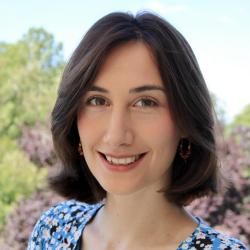Highlighting the individuals who have contributed and helped others in the Driscoll Group, DMG, and University.
Muireann de h-Óra
Muireann joined the Driscoll Group in 2020 as a Marie Skłodowska-Curie PhD student within the BeMAGIC international training network. Her research focused on voltage control of magnetism, specifically exploring magneto-ionic and magnetoelectric effects in vertically aligned nanocomposite (VAN) films. By engineering VAN films with large interfacial areas, Muireann aimed to enhance ionic motion and magnetoelectric coupling in CoFe2O4-based systems. She worked with pulsed laser deposition (PLD) to fabricate VAN films and used techniques such as MPMS and VSM to characterise their magneto-ionic and magnetoelectric properties. In addition to her primary research, Muireann collaborated on projects related to ferroelectrics, superconductivity, Li-ion batteries, and various magnetic phenomena.
Muireann is now a renewable energy engineer for AusNet in Australia, contributing to the transition towards a sustainable future and helping Victoria achieve its NetZero goals.
Muireann was a vital part of the group, always keen to help and a lead on many projects, roles or tasks that keep the lab moving forward. Congratulations on your PhD achievements from the whole group, and we will miss you! We're excited to see your next big achievements.
Tom Bedford
Tom's PhD investigated the growth and characterisation of high-temperature superconductors for high-field magnet applications. More specifically, he focused on analysing structural and superconducting properties of commercial HTS tapes and studying different pinning centre morphologies for their effectiveness in temperature and magnetic fields relevant to function magnet applications.
Tom has now graduated and moved to Tokamak, where he is working on exciting new projects in fusion energy and magnets. The group is thankful for the expertise he brought and the unwavering support and helpful guidance to his colleagues. We wish you best of luck on your new endeavor.
May Hsim Lai
May Hsim joined the group in 2017, and has conducted her PhD thesis on high temperature thin film semiconductors. May Hsim's teamwork and collaborative ways have brought the group together, and her commitments to the lab have been hugely appreciated by all us co-workers. As a researcher, her focus and direction have proved her a great scientist. We congratulate May Hsim on recently passing her viva examinations, and wish her the best of luck in her future endeavors.
Erik Landberg
Erik has been an essential member of the group in his time with us! His expertise and know-how in technical matters has enabled the group research to run effectively, and his input has improved our facilities. Beyond the lab, Erik has always brought people together and helped everyone to feel welcomed in the group. You will be missed!
Megan O. Hill
Megan has been a great member of the team, hosting a prestigious Herchel Smith Fellowship for 3 years. Megan has not only been undertaking advanced HAXPES analysis of ferroelectric device structures but has also worked very proactively to help the group and our external collaborators in interpreting the chemistry and electrical behaviour of their samples using XPS and UPS. She has managed our tricky XPS/UPS system, constantly trouble shooting, making it work and then analysing samples from both within the group and across the University. Megan has been our resident expert on electron backscatter diffraction, kindly helping several out with in-depth analysis of their film textures. Megan also ran our memory meeting seminars for a year, arranging speakers and chairing the meetings. Finally, she has also been very kind in keeping the group sane during the difficult pandemic times, e.g. arranging outdoor social events. The group are all so grateful to Megan for all she has done to help everyone beyond her own research.
Nives Strkalj
Nives has joined the group in March 2021 as a Postdoc Mobility fellow of the Swiss National Science Foundation to study resistive switching based on ferroelectricity and ionic reconfigurations. Her passions for nanoscale ferroelectricity and sharing knowledge have been a great asset to the group, motivating others to join her quests. Her contagious enthusiasm and unwavering patience have made her the first point of contact for scientific discussions related to phenomena in ferroelectric-based heterostructures, both within the group and in several collaborations. Nives has further been managing the advanced pulsed laser deposition system with reflection high energy electron diffraction, keeping it running smoothly throughout her stay. She has reestablished the use of piezoresponse force microscopy in the group, selflessly training users from our and other groups, and developing measurement protocols for detecting ferroelectricity. She has also been our local expert on x-ray reflectivity and diffraction, particularly strain and defect analysis. She has served as the liaison to the Di Martino group, continuously improving the sample design for collaborative projects on optical spectroscopy. The group is thankful for the expertise she brought to the group and even more for her kind uplifting guidance when Nature becomes shy revealing it’s true nature.




